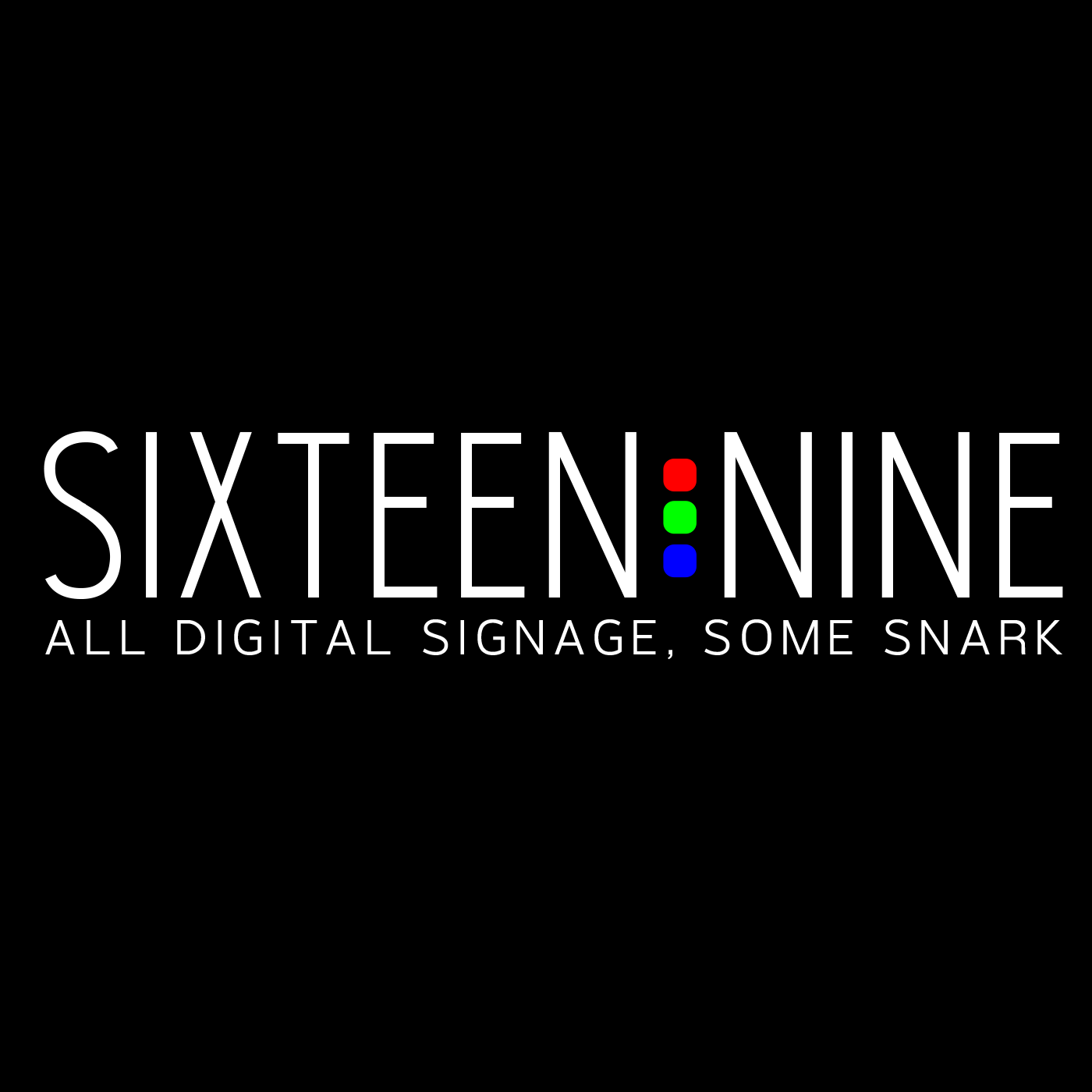Episodes

Wednesday Apr 10, 2019
Sean Matthews, Visix
Wednesday Apr 10, 2019
Wednesday Apr 10, 2019
Sean Matthews managed to break away from booth set-up at Digital Signage Expo - well, actually he was probably happy as a clam to get away from the noise and bustle - to sit down and talk about Visix, the Atlanta-based CMS software company he's ran for many years.
While many of his software competitors have been all over the place chasing whatever vertical presented an opportunity, Matthews has pretty steadfastly kept Visix focused on a couple of key vertical markets - higher education and workplaces. There are more than 1,000 Visix systems operating on college and university campuses.
We had a wide-ranging talk outside the North Hall at the Las Vegas Convention Center, and you'll probably pick up some of the bustle ahead of the show opening. Matthews gets into the roots of Visix, what's worked for the company, and where things are going.
Subscribe to this podcast: iTunes * Google Play * RSS

Wednesday Apr 03, 2019
Jeremiah Archambault, ENS
Wednesday Apr 03, 2019
Wednesday Apr 03, 2019
Every year or so, Jeremiah Archambault rings me up, usually out of the blue, from his office in Victoria, BC, on the very west coast of Canada.
He runs a decade-old company called ENS that has, for that time, been steadily developing a digital signage CMS software and management platform, that's now called SAM. With each call, he's given me an update on what's new with the platform and his seemingly endless testing and refinement. I've always finished off the conversation intrigued by what he was putting together.
A decade on, his company has built up a decent footprint of everything from small to enterprise clients, and he's now at a point where things are getting serious. I spoke with him, this time, from the outbound marketing and inbound support call center he's set up and has running in the Philippines. He's aggressively signing up and on-boarding new business partners, with a particular focus on print and sign shops that now know they need to add digital capability, but want it white-labeled and managed by someone else.
In this podcast, we chat about the roots of the company, and a lot of lessons learned about deployment, hardware and dealing with pesky humans. We also get into how he's about to finally get noisy about his solution, with a freeware model that uses a PC stick he's dead-certain is reliable and ideally suited to digital signage.
Subscribe to this podcast: iTunes * Google Play * RSS

Wednesday Mar 13, 2019
Bjorn Pieper, NDS
Wednesday Mar 13, 2019
Wednesday Mar 13, 2019
The Dutch software company NDS has been offering a digital signage software solution for 25 years now, and like the handful of other companies that have been around this business that long, they've survived and grown based on the ability to do certain things very well.
In the case of NDS, the company's roots and core business are at airports. That started with getting arrivals and departures data up on passenger terminal screens, and over the years, grown more sophisticated.
Airports are cities, in many respects, and they are the precursors for the smart cities digital signage networks that are starting to bubble up globally. You tie into a lot of systems, and what's visualized on the screens reflects what is going on, more broadly, in the facility or area.
I spoke with Bjorn Pieper, the Chief Commercial Officer for NDS, about how his company works not only with airports, but a lot of big corporations, to make digital signage networks that are truly smart.
Subscribe to this podcast: iTunes * Google Play * RSS

Wednesday Feb 20, 2019
Alberto Cáceres, Trison
Wednesday Feb 20, 2019
Wednesday Feb 20, 2019
Being in Amsterdam for ISE recently offered a chance to meet up and talk to some people who are squarely focused on business on the other side of the Atlantic.
I knew Trison was a major player in digital signage solutions in its home country of Spain, but I didn't realize the company had a far greater reach than that. In 2018, Trison was in the middle of 2,500 digital signage and related jobs, in 76 countries.
The company started 20 years ago doing audio solutions, in northwest Spain, and has grown into the major solutions provider for retail digital signage in Europe and beyond. A Coruna is home base, but Trison has offices in Madrid, Barcelona, Paris, Shanghai, Mexico City and elsewhere.
I spoke with CEO Alberto Cáceres outside the ISE press room.
Subscribe to this podcast: iTunes * Google Play * RSS

Wednesday Dec 12, 2018
Kaan Gunay, Firefly
Wednesday Dec 12, 2018
Wednesday Dec 12, 2018
There's nothing new about media on taxi tops, but a San Francisco start-up called Firefly is trying to go about it with a different approach.
Firefly describes itself as the first mobility-based SmartScreens platform - an advertising media firm that gets it footprint and scale from the rideshare industry.
Firefly is working primarily with the drivers for services like Uber and Lyft, offering a supplemental revenue stream in return for fixing a hyper-local, geo-fenced digital sign on the cartop. Firefly absorbs the capital cost, and spins off an average of $300 a month to the driver. That money isn't huge, but it can be enough to significantly offset leasing or insurance costs and make driving for a living worthwhile.
Co-founder Kaan Gunay is a mechanical engineer by training, but in recent years has found his way to Stanford, where he got his MBA and where the roots of Firefly first developed. He's also very active in community good works, and we spoke about how continuing that was, and is, fundamental to how Firefly does things.
At least 10 percent of all media on screens goes to to promote and advertise local not-for-profit organizations and provide public service announcements for non-commercial entities such as charities.
The car-toppers have sensors - for things like air quality - that generate data that's open for government planners, and others, to use.
I spoke with Gunay last week, just as his company was announcing a big $18.5 million seed funding raise.
Subscribe to this podcast: iTunes * Google Play * RSS

Wednesday Dec 05, 2018
Kaijus Asteljoki, Valotalive
Wednesday Dec 05, 2018
Wednesday Dec 05, 2018
Workplace communications is one of the most active verticals in digital signage, and a big reason for that is the ability of screen technology to get important information to staff - without hoping they open and read mass emails or see posters on breakroom cork boards.
The Finnish startup Valota saw the rise in business-based digital signage coming, and has been developing a product totally focused on visual messaging in the workplace.
Based outside Helsinki, the company's Valotalive product is a messaging platform built around a growing set of content presentation apps that visualize data from widely used business systems like Salesforce and Microsoft's Power BI.
The platform enables set it and forget it content that's fed via these systems - so when the KPIs for a company change, they change automatically on screens located around facilities. It's a big step up from Happy Birthday wishes and notices about the parking lot being paved on the weekend.
I spoke with CEO Kaijus Asteljoki about the roots of Valotalive, and what he says are the key things end-users need to think about when putting together a digital screen network for their workplaces.
Subscribe to this podcast: iTunes * Google Play * RSS

Wednesday Nov 28, 2018
Ryan Croft, TransitScreen
Wednesday Nov 28, 2018
Wednesday Nov 28, 2018
This is inadvertently turning into transit digital signage month on this podcast, having spoken lately with CHK America about epaper transit signs and just last week with Roadify, which aggregates data from transit systems.
This week I'm talking to Ryan Croft, one of the co-founders of TransitScreen, which has made a mark in North America and globally with a subscription service that puts together and presents on screens all the mobility options for people at specific venues.
What that means in practical terms is people coming down in late afternoon to the lobby of their office block, and looking at a carefully-considered and laid-out screen that shows everything from the state of local buses and trains to the availability of Uber, Lyft and some of the other alternative transport options out there these days.
In our chat, we get into how TransitScreen got started, what they've learned along the way, why they've now added a mobile app, and how the sort of data insights all this mobility data is generating might have some interesting new uses.
Subscribe to this podcast: iTunes * Google Play * RSS

Wednesday Nov 21, 2018
Scott Kolber, Roadify
Wednesday Nov 21, 2018
Wednesday Nov 21, 2018
Mass transport data is some of the stickiest content out there for digital signage screens. It's information people tend to want and need, and they'll habitually look at screens to get it.
Tapping into the open data from one transport authority, to show it on screens, is relatively easy. It gets more complicated when you want to show data from multiple systems on a screen, and it gets quite complicated when the signage network wants to run data specific to different cities and different transit systems.
It would be a bear for a software or solutions company to take on, which is the attraction of a Brooklyn-based service called Roadify - which aggregates all that data from different systems and presents it all in one structured format, using its platform and running off a subscription model.
The service is similar to some of the news, weather and sports feed aggregators that have long operated in this sector, except the content is quite different. I spoke with founder and CEO Scott Kolber about the roots of Roadify, and how his company's services are being used.
Subscribe to this podcast: iTunes * Google Play * RSS

Wednesday Oct 31, 2018
Rich Ventura, NEC Display, on ALP
Wednesday Oct 31, 2018
Wednesday Oct 31, 2018
NEC Display has been fairly quietly involved in analytics for a long time now, but it just got very serious and noisy about that capability, with the launch of something called ALP - which is short for Analytics Learning Platform.
It's a retail intelligence program that uses cameras and other sensors, AI, big data, cloud computing and network appliances to give retailers a better sense of what's going on in their stores.
Tied to digital signage, a retail intelligence platform can optimize messaging based on who's in there, how long they're in there, and the historical patterns of what those people tend to buy. The gold for retail operators is understanding conversion ratios - the what really happened stuff when messages were pushed.
There is no shortage of retail intelligence platforms out there, but none that I know of built from the ground up with signage as a core element. I spoke with NEC's Rich Ventura, who drove the project, to talk about ALP's roots, how people in the signage ecosystem plug in, and how it all fits.
Subscribe to this podcast: iTunes * Google Play * RSS

Wednesday Oct 24, 2018
Rick Wood, CHK America
Wednesday Oct 24, 2018
Wednesday Oct 24, 2018
Rick Wood's company was founded to bring some order and logic to how mass transport systems present information - like routes and schedules - to passengers.
It was a tall order for CHK America - because many or most transport authorities had their own way of doing things, and not that many were particularly good at making it easy and familiar for people to find their way around.
But the company has seen a lot of success, and its best practises have been widely adopted. When people take unfamiliar buses and subways in cities they visit, there's a reasonable chance the information on the signs they see now look familiar and can be readily understood. Ideally, CHK says people should be able to find out what they need in eight seconds.
It's a mindset smart digital signage people have come to understand ... in essence, you have a matter of a few seconds to inform people before they look somewhere else.
All the understanding of how people seek and consume information is now being applied by CHK, through a spinout called ConnectPoint, to digital displays. The company started with big interactive screens, but now the really interesting work is with dynamically-updated, solar-powered e-paper signs at bus stops.
In this week's podcast, I spend a lot of time talking to Wood about how mass transit users find and use information, and how all this translates from static to digital displays.
Subscribe to this podcast: iTunes * Google Play * RSS

Tuesday Sep 18, 2018
Hongwei Liu, Mappedin
Tuesday Sep 18, 2018
Tuesday Sep 18, 2018
Wayfinding is one of those core technologies that make consumer lives better and easier - helping people locate where they want and need to go in places like shopping malls, airports, health care facilities and higher ed campuses.
There are numerous software companies that include wayfinding capabilities in their platforms, but only a handful that have been laser-focused just on delivering that solution. One of the most successful ones is Mappedin.
The company started as a sideline for some students at the University of Waterloo, which most observers would call the top computing school in Canada. Hongwei Liu and his buddies thought they could solve a problem for students finding their way around the sprawling Waterloo campus, and then at a local mall and a casino a couple of hours up the highway.
There was enough there for Liu to quit school in his second year. Just a few years later, he's running a company with 60 employees, some big outside investors, and clients across North America and globally.
I spoke with Liu about Mappedin's roots, what works and doesn't, and how the big moment came when serious research showed good wayfinding can mean millions of dollars in incremental sales for shopping malls and their tenants.
Subscribe to this podcast: iTunes * Google Play * RSS

Wednesday Sep 12, 2018
From The Archive: Michael Schneider On Experiential Digital Design
Wednesday Sep 12, 2018
Wednesday Sep 12, 2018
No new podcast this week ... sorry.
I had two postponed interviews last week, combined with a short work week and then me spending two of those four days in a succession of airplanes getting to and from a client. I'm kinda remote now, and so are they.
I have two chats scheduled for Thursday, and more in the hopper. I'm also happy to get suggestions on people/companies I should be making subjects of an episode, so send your suggestions along.
That stated, it's an archive week. Enjoy this podcast chat from late 2016 with Michael Schneider, who was with the experiential design firm ESI Design at the time, but sent me a note last week to say he's joined the NYC office of the big, global architecture and design firm Gensler, as Creative Technology Director – Hardware.
He's left a great firm, but gone to another great one. Smart, soft-spoken guy, involved with some phenomenal projects.

Wednesday Aug 29, 2018
Refik Anadol, On Digital Data Sculptures
Wednesday Aug 29, 2018
Wednesday Aug 29, 2018
If finding a free half-hour to talk is any indication, Refik Anadol is one busy, popular guy right now. That likely owes a lot to the mind-blowing data visualization work he's been doing lately in public spaces.
He's a Turkish-born digital media artist who now has a busy studio in Los Angeles doing what he calls parametric data sculptures for public art spaces.
If you have been in downtown San Francisco, you may have seen a big LED video wall in the lobby of a Salesforce tower that seems to have a corner glass window with live expanding foam - or something. It looks real, but it's just three-dimensional digital art, driven by data.
More recently, he's done several sync'd up visualizations on the LED walls of an expanded section of Charlotte, North Carolina's airport. What's happening on the screens there is all based on real-time data from airport operations. So what you see on the screens is shaped by things like luggage-handling systems.
Kinda crazy.
I caught up with Anadol recently at his LA studio, to get a sense of what he and his team does, and we have a broader discussion about visualized data.
Subscribe to this podcast: iTunes * Google Play * RSS

Wednesday Aug 15, 2018
Kyle Pilot, iGotcha
Wednesday Aug 15, 2018
Wednesday Aug 15, 2018
I was in Montreal recently and had a chance to visit the offices of iGotcha, a digital signage and experiential media solutions company that has very quietly built up a nice book of business since launching in 2005.
Working out of an old warehouse building overlooking the historic Lachine Canal, iGotcha works with everyone from banks and a lottery corporation to Cirque du Soleil.
I caught up with Kyle Pilot, one of the co-founders and the longtime CTO. He now runs the company with business partners Greg Adelstein and Hadrien Bessou.
In this chat, we get into what they do, who they work with, and get on a fairly lengthy riff about the merits of technology like System on Chip displays.
Subscribe to this podcast: iTunes * Google Play * RSS

Wednesday Jul 18, 2018
Gordon Feller, Meeting Of The Minds (Smart Cities)
Wednesday Jul 18, 2018
Wednesday Jul 18, 2018
I can't say I've been all the enthralled by what I've seen so far with smart cities initiatives that involve digital out of home media companies. For the most part, they're just digital posters with some wifi and maybe some sensors tossed in so the things can be called "smart."
Those things exist to run ads, and the "smart" thing is largely a veneer to get the ad concession, and for city governments to get free stuff that purports to make their burg seem somehow innovative.
BUT ... there's a lot of potential there, and when you talk to someone who spends all his time thinking about and working on smart city initiatives, you learn there are some good things happening not only with broader smart initiatives, but also with efforts that DO involve media companies.
I wrote a mildly snarky piece recently about this stuff, and Gordon Feller sent me a note suggesting I have a look at a report he did for the Outdoor Advertising Association of America. He's a longtime Silicon Valley tech exec and founder of Meeting Of The Minds, a non-profit public-private partnership that's all about creating smarter cities.
We had a frank talk about what's happened to date, where it really works, and what he sees as the vast potential for smart cities that work with media companies and digital signage technologies.
Subscribe to this podcast: iTunes * Google Play * RSS

Wednesday Jul 11, 2018
Nick Fearnley, Signstix
Wednesday Jul 11, 2018
Wednesday Jul 11, 2018
I am guilty of thinking about SignStix as yet another smallish digital signage CMS company scratching out a living with low-cost subscriptions and equally low-cost Android stick players.
Based in Yorkshire, England, SignStix is a lot more than that. The company is indeed small, but doing some stuff that is a little bit mind-blowing. It does digital signage, but for some significant clients it is doing a lot of back-of-the-house data-mining and aggregation for communications that go beyond screens.
What I found really interesting is learning from CEO Nick Fearnley how the company is using the intelligence on system on chip "smart" displays to do things like manage and aggregate geo-fencing data from trucks moving in and out of a retailer's loading docks. It's stuff that would much more normally be done by full PCs, and it is completely counter to the suggestion still out there that these smart displays aren't all that bright.
Fearnley and I chatted at the back of one of the halls at InfoComm, last month in Las Vegas. You'll enjoy the chat, and particularly his Yorkshire accent.
Subscribe to this podcast: iTunes * Google Play * RSS

Wednesday May 02, 2018
Jason Bier, Federation For Internet Alerts
Wednesday May 02, 2018
Wednesday May 02, 2018
One of the time-honored lines used in digital signage and digital out of home media is how the technology gets the right messages to the right people at the right times.
That's all had to do with marketing and advertising, but a non-profit called the Federation for Internet Alerts has a mission to get crucial alerts in front of the right people at the right times and places to save lives and rescue kids.
Based on years of volunteer work from top coders, pro bono support from agencies and web services, and some grants here and there, the organization is sending critical alerts across North America that warn people about imminent threats like tornadoes, and more insidious threats like bad air.
Almost 1.5 million alerts have been processed since the platform started, and while most of that has been for web and mobile, now the organization is talking to digital out of home media companies about how its alerts could be on big digital screens that are everywhere, and always connected.
I spoke recently with the organizations founder and volunteer CEO, Jason Bier.
Subscribe to this podcast: iTunes * Google Play * RSS

Wednesday Feb 28, 2018
Bryan Crotaz, Silver Curve
Wednesday Feb 28, 2018
Wednesday Feb 28, 2018
The top prize at the Digital Signage Awards that were announced and handed out recently in Amsterdam was a project to modernize the display system at the cradle of cricket - Lord's Cricket Ground in London.
The project was pulled together by a small London consultancy called Silver Curve, which is run by one of the brightest minds in digital signage, Bryan Crotaz.
Bryan had been telling me about the project for more than a year, but he was only recently in a position to make some noise about it.
In our conversation, we talk about the effort to modernize and greatly simplify the display control system on the ancient grounds, and how he used very technologies like HTML5 and Raspberry Pi to make it all happen.
Subscribe to this podcast: iTunes * Google Play * RSS

Wednesday Dec 13, 2017
Manolo Almagro, Q Division
Wednesday Dec 13, 2017
Wednesday Dec 13, 2017
Just last week Manolo Almagro pulled the curtains back on a new company he's started, under the umbrella of Chris Riegel's ever-growing STRATACACHE empire.
It's called Q Division, a retail tech consultancy that in many respects is the sum total reflection of 20-plus years that Manny has been around tech, in a crazy variety of ways.
His roots go back to desktop publishing for print, but somehow or other he ended up working with an agency that had McDonald's as a client - and he was behind putting digital menu boards into the QSR chain back in the 90s, before flat panels were even around. They used Macs and big-ass rear-projection cubes to pull it off.
He's since been an early adopter and, in many respects, an evangelist and guru for a lot of emerging technologies for online, mobile and in retail.
I caught up with him late last week, and we had a great conversation that got a little out of control here and there.
Subscribe to this podcast: iTunes * Google Play * RSS

Wednesday Nov 22, 2017
Michael Clarke, Citilabs
Wednesday Nov 22, 2017
Wednesday Nov 22, 2017
The digital out of home media industry has been growing rapidly, and as awareness has built, there’s been more and more of a push from brands and media buyers to provide better, deeper detail on the actual audience.
The old way of selling audience for outdoor was gross traffic counts and extrapolations on what they meant. The new way is big data, and a Sacramento company called Citilabs is working with the out of home industry’s main guys on audience measurement, Geopath, to provide what they call a complete knowledge of how Americans move around their country.
When you have a deep understanding of patterns, volumes and demographics, you can fine-tune advertising and make it more effective and attractive.
In this episode, I talk to Citilabs CEO Michael Clarke about what the company does, how it does it, and what that means not only for digital out of home advertising, but for interesting stuff like data visualization.
Subscribe to this podcast: iTunes * Google Play * RSS


